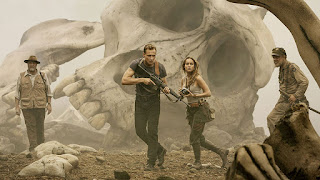After Oscar season, I usually find myself playing catch-up,
trying to see some of the acclaimed and nominated films that I missed in
theaters. This week, I finally had a chance to see Hell or High Water, the elegiac western noir starring Chris Pine,
Ben Foster, and Jeff Bridges.
One convention of film noir is the ambiguous protagonist.
Film noir leading characters are never outright heroes nor are they always
straight-up villains. They’re usually morally ambiguous people who are a
combination of selfishness and greed along with a warped but strong personal
code. They’re usually driven by something like greed or revenge but they also
have their own sense of wrong or right.
This is absolutely true of Hell or
High Water, the story of Toby and Tanner Howard, two Texan brothers whose
mother died of a long, lingering illness and left their ranch on the verge of
belonging to the unscrupulous Texas Midlands Bank.
Chris Pine plays Toby, the divorced father of two who has
always tried to stay on the straight and narrow. Ben Foster is Tanner, the
unpredictable, violent brother who has been in and out of prison for years and,
as it is revealed, shot and killed their abusive father. Toby is the
respectable, law-abiding one and he’s also the smart brother, so he is the one
who figures out how to rob several Texas Midlands branches to pay off the debt
on the ranch that’s owed to the bank. Toby knows that it’s wrong to hold people
at gunpoint and steal money, but in his mind, it is more wrong for a bank to
loan money to a dying woman who everyone knew could never pay it back. He isn’t
stealing for personal gain, the thrill, or the glory. He’s stealing because he
feels the system is rigged against people like him, his mother, and his
brother. It’s a bleak crime thriller very much for our times.
Jeff Bridges plays Texas Ranger Marcus Hamilton who, along
with his partner Alberto Parker is on the brothers’ trail. One subtle but
powerful theme throughout the film is brotherhood. We see Toby and Tanner’s
familiarity and brusque macho love for each other and we see Marcus and
Alberto’s antagonistic, tired tolerance for one another throughout the film.
Each pair of men show their affection and devotion to one another in radically
different ways, often in ways that don’t seem much like love at all. But for
anyone who has brothers, it seems perfectly appropriate.
Marcus and Alberto’s relationship is particularly
interesting in that Marcus is casually racist and insulting about Alberto’s
Native heritage, and his partner seems like he can barely wait for the older
man to retire and leave him alone. But late in the film when Alberto is shot by
one of the Howard brothers, Marcus’s grief is palpable and real. It’s the part
of his performance that earned Jeff Bridges the Oscar nomination he received,
no doubt.
Another convention of film noir is the ambiguous ending.
There are rarely, if ever, happy endings in noirs and Hell or High Water is no different. Toby and Marcus face off at the
Howard family ranch. Both men have lost loved ones over the course of the film,
both are weary but clear eyed about their place in the world and where they
stand with one another. Rather than going with the easy Hollywood shootout or
the equally easy, let-‘em-off-the-hook unambiguous happy ending, the film’s
conclusion leaves the fate of the one remaining Howard brother and the now
retired Texas lawman up in the air, the conclusion suspended in the tension
between them.
The film shows the financial decay of some of the open,
rural spaces in the American west and the personal, inner decay that can happen
because of it. There are no heroes in Hell
or High Water, but it does suggest that there’s a larger, villainous system
at work that can push good people to go bad.



